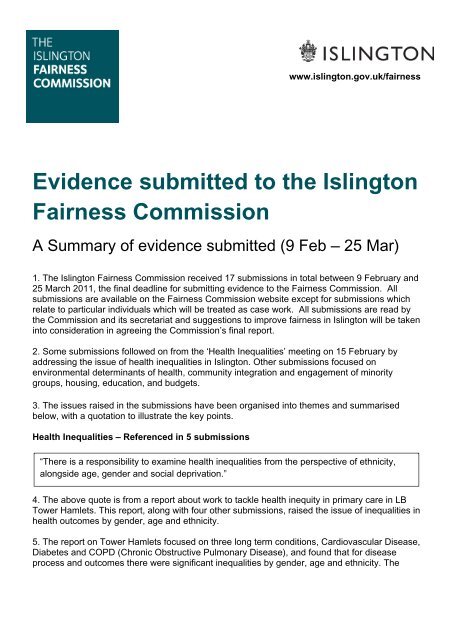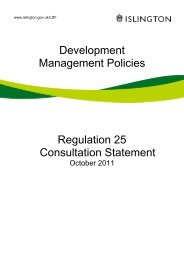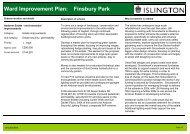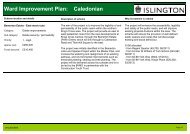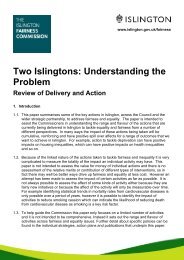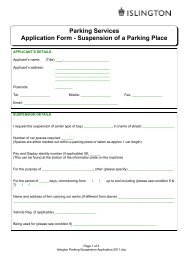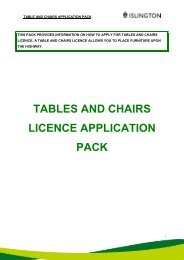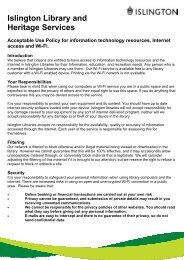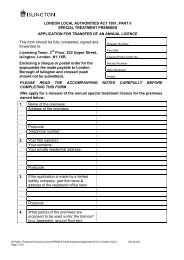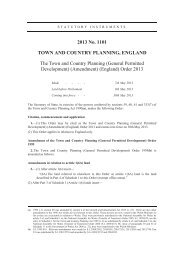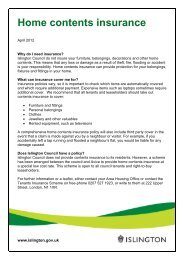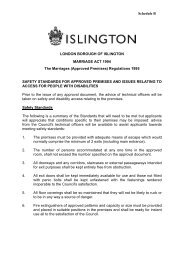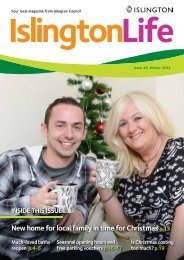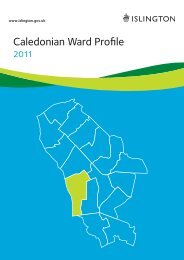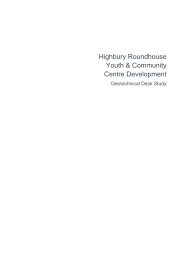Final Evidence Summary 9th Feburary - 25th ... - Islington Council
Final Evidence Summary 9th Feburary - 25th ... - Islington Council
Final Evidence Summary 9th Feburary - 25th ... - Islington Council
You also want an ePaper? Increase the reach of your titles
YUMPU automatically turns print PDFs into web optimized ePapers that Google loves.
www.islington.gov.uk/fairness<br />
<strong>Evidence</strong> submitted to the <strong>Islington</strong><br />
Fairness Commission<br />
A <strong>Summary</strong> of evidence submitted (9 Feb – 25 Mar)<br />
1. The <strong>Islington</strong> Fairness Commission received 17 submissions in total between 9 February and<br />
25 March 2011, the final deadline for submitting evidence to the Fairness Commission. All<br />
submissions are available on the Fairness Commission website except for submissions which<br />
relate to particular individuals which will be treated as case work. All submissions are read by<br />
the Commission and its secretariat and suggestions to improve fairness in <strong>Islington</strong> will be taken<br />
into consideration in agreeing the Commission’s final report.<br />
2. Some submissions followed on from the ‘Health Inequalities’ meeting on 15 February by<br />
addressing the issue of health inequalities in <strong>Islington</strong>. Other submissions focused on<br />
environmental determinants of health, community integration and engagement of minority<br />
groups, housing, education, and budgets.<br />
3. The issues raised in the submissions have been organised into themes and summarised<br />
below, with a quotation to illustrate the key points.<br />
Health Inequalities – Referenced in 5 submissions<br />
“There is a responsibility to examine health inequalities from the perspective of ethnicity,<br />
alongside age, gender and social deprivation.”<br />
4. The above quote is from a report about work to tackle health inequity in primary care in LB<br />
Tower Hamlets. This report, along with four other submissions, raised the issue of inequalities in<br />
health outcomes by gender, age and ethnicity.<br />
5. The report on Tower Hamlets focused on three long term conditions, Cardiovascular Disease,<br />
Diabetes and COPD (Chronic Obstructive Pulmonary Disease), and found that for disease<br />
process and outcomes there were significant inequalities by gender, age and ethnicity. The
eport also highlighted that inequalities in service provision can be hidden and are not always<br />
easy to identify.<br />
6. Health equity audits were conducted to demonstrate the differences between experiences of<br />
different groups and the data from the audits could then be used by primary care teams. The<br />
report stated that although there were improvements across all local PCTs for most disease<br />
indicators, health inequalities are persistent and need to be continually reviewed.<br />
7. Two submissions highlighted the health inequalities experienced by Black and Minority Ethnic<br />
(BME) communities in <strong>Islington</strong>. A report from the Women’s Association for African Networking<br />
and Development (WAND UK) argued the need for targeted support for BME women and<br />
cultural sensitivity on the part of health service providers. The report identified that some of the<br />
key barriers to BME women accessing health services include financial constraints and a lack of<br />
information about what services are available to them.<br />
8. A report from the <strong>Islington</strong> Refugee Forum (IRF) made similar points that a lack of clear<br />
information and a lack of cultural sensitivity can prevent refugees from accessing health<br />
services. The report highlighted further barriers for refugees including language barriers and a<br />
lack of interpreters in health service contexts, and the impact of the trauma and stress of coping<br />
with a new environment and integrating into a new community.<br />
9. Both reports stressed the importance of effective signposting and information and advice<br />
from GPs, as GPs form the gateway to other services. The importance of having interpreters<br />
and information in a range of languages at the GPs was also emphasised.<br />
10. Two submissions argued that health services are not sufficiently tailored to address the<br />
sometimes complex needs of elderly people and those with disabilities. One submission argued<br />
that there is too strong a tendency for a ‘one size fits all’ approach in health and social care<br />
services and that therefore the support and advice provided may be inappropriate. The<br />
example given was that for someone who lives alone and on a low income the weight loss<br />
advice they receive may often be tailored at couples and families, or the ingredients they are<br />
recommended to use may be too expensive.<br />
11. One submission argued similarly that health services are not sufficiently adapted to the<br />
needs of elderly people wishing to live independently in their own homes, and that this failing is<br />
likely to lead to more older people being admitted to hospital.<br />
Health Determinants – Referenced in 4 submissions<br />
“Local authorities can respond to the challenges and expectations placed upon them to<br />
improve as far as possible local environmental conditions...to improve local housing<br />
conditions; to improve workplace safety & promote healthy options and alternatives to the<br />
community.”<br />
12. The quote above is from a submission about the work of the Environmental Health teams<br />
within <strong>Islington</strong> <strong>Council</strong>. The submission elaborates on the work of the team and provides<br />
evidence on how the wider environment and individuals’ living and working conditions are key<br />
determinants for their physical and mental health.
13. Another submission came from the Local Involvement Network (LINk) about the relationship<br />
between housing and health and it made many similar arguments to the environmental health<br />
submission.<br />
14. Both submissions evidenced the range of physical and mental health issues that can result<br />
from living in poor housing conditions and in a physical environment with very little green space,<br />
poor air quality, noise pollution, crime, litter etc.<br />
15. The LINk report specifically details the impacts that poor housing conditions have been<br />
found to have on health, and references calculations done by the Building Research<br />
Establishment which estimated that poor housing costs the NHS at least £600 million per year.<br />
16. The report identified eight hazards of poor housing that can cause ill health: damp and<br />
mould, cold homes and fuel poverty, exposure to house dust mites and other allergens,<br />
overcrowding, rodent and other pest infestations, prevalence to slips, trips, falls and other<br />
accidents, and a lack of housing aids and adaptations for independent living. These hazards<br />
can lead to a range of conditions including asthma and respiratory problems, eczema and<br />
conjunctivitis, infectious diseases such as TB, accidents, injuries and fatalities (through<br />
accidents or excess winter deaths). With all these conditions, it is often children who are the<br />
most susceptible and at risk.<br />
17. The submission also referenced a report by the British Medical Association which argued<br />
that it is often the most vulnerable people (the very young and the very old, people with long<br />
term illness etc) who are the most likely to be affected worst by the hazards associated with<br />
poor housing because of the long periods of time they spend in their homes.<br />
18. According to LINk’s report the highest rates of non-decent housing are generally found in<br />
the private-rented sector and within that some of the worst housing conditions are found in<br />
housing in multiple occupation (HMOs). Those who are homeless or in temporary<br />
accommodation have the worst health outcomes; the life expectancy of someone sleeping<br />
rough in the UK is about forty years.<br />
19. The report included 2007 survey data for <strong>Islington</strong> which estimated that 15,899 households<br />
in <strong>Islington</strong> (18.1%) were living in unsuitable housing with the main reasons being overcrowding,<br />
special needs and need for repairs. The rate of overcrowding in <strong>Islington</strong> was estimated at<br />
6.9%, mostly concentrated in the social rented sector. The key argument is that to reach a state<br />
of equality in health outcomes, all housing in <strong>Islington</strong> must be of a decent standard that is<br />
conducive to a healthy lifestyle.<br />
20. One submission came from the Seasonal Health Interventions Network (SHINE) and<br />
outlined the fact that hundreds of <strong>Islington</strong> residents are admitted to hospital or die every year<br />
due to health problems associated with extreme cold and hot weather. SHINE is a partnership<br />
between The <strong>Council</strong> and the NHS in <strong>Islington</strong>, established in December 2010, and aiming to<br />
tackle fuel poverty and reduce excess seasonal deaths and hospital admissions in <strong>Islington</strong>.<br />
The submission asked that Commissioners note SHINE as an effective partnership in bringing<br />
together different agencies and improving the health and wellbeing of vulnerable residents.<br />
21. Another submission came from a national project called the Health Empowerment Leverage<br />
Project (HELP) that supports residents to transform the conditions of their neighbourhood in<br />
conjunction with the full engagement of the different agencies. The submission advocated for<br />
the opportunities presented by localised health commissioning for greater investment at the<br />
neighbourhood level as a way of tackling spacial inequalities. The project does not currently
work in <strong>Islington</strong> but the submission suggested that an area like the Bemerton Estate would be<br />
a good candidate for their initiative.<br />
Housing – Referenced in 1 submission<br />
“These changes will enable residents to make more informed decisions about their housing<br />
earlier, and will enable the HfI and LBI to deliver a better service to those with a high level of<br />
need.”<br />
22. The quote above is from a submission about a Joint Efficiency Review (JER) undertaken of<br />
the housing process by HFI and the <strong>Council</strong>’s Housing Team. The submission states that on<br />
the basis of the Review’s findings the service plans to introduce a face-to-face and telephone<br />
assessment and advice service, change the verification process, and review and amend the<br />
lettings process.<br />
23. The submission argued that these changes would enable better communication, quicker<br />
decisions and make the service more responsive to need, and would bring about the benefits<br />
highlighted in the quote above.<br />
Minority Groups – Referenced in 2 submissions<br />
“The situation of BME women and children in <strong>Islington</strong> is largely characterised by: Poverty,<br />
income inequality, violence against women, housing difficulties, inequality in access to<br />
health services, invisibility to local decision making and under representation in public sector<br />
employment”<br />
24. Two submissions focused on the disadvantage experienced by minority groups in <strong>Islington</strong>,<br />
specifically refugees and those from Black and Minority Ethnic communities. Some of these<br />
issues and how they relate to health are covered above, but the submissions referred to a wide<br />
range of areas of disadvantage.<br />
25. The report from the Women’s Association for African Networking and Development (WAND<br />
UK) focused on the position of BME women in <strong>Islington</strong> and argued that the lives of BME<br />
women and children in the borough are largely characterised by poverty, income inequality,<br />
violence against women, housing difficulties, inequality in access to health services, and an<br />
invisibility in local decision making.<br />
26. The submission reported high instances of domestic violence and sexual violence in<br />
<strong>Islington</strong>, and argued that BME women have the worst experiences of housing in the Borough,<br />
are overrepresented among the homeless in <strong>Islington</strong>, and are less likely to interact with<br />
<strong>Council</strong>lors and elected officials to have their views heard.<br />
27. The report recommended that BME women be empowered and have greater access to<br />
training and education to overcome language barriers, social isolation and all barriers to<br />
integration, and emphasized the fact that the key to reducing child poverty is empowering<br />
women who may not have the financial support of a partner.<br />
28. The submission from the <strong>Islington</strong> Refugee Forum went through evidence on the<br />
experiences of refugees in the key areas in the Refugee Integration Strategy: community
integration, health, housing, employment and education and argued that refugees experience<br />
significant disadvantage in all these areas.<br />
29. Language barrier was identified as one of the biggest barriers that limits refugees in terms of<br />
their access and outcomes in all these areas. The lack of appropriate and accessible ESOL was<br />
raised as a very big issue, with a stress on the need for more entry-level and pre- entry-level<br />
classes, and a need to reduce the prohibitive waiting lists.<br />
Family Support and Community Integration – Referenced in 3 submissions<br />
“Community Centres are often in the centre of housing estates, perhaps there should be an<br />
emphasis on re-generating to become the 'hub' of the community. People from the<br />
surrounding area could be encouraged to take a very active part in running and maintaining<br />
'their' centres enabling sustainability and growth.”<br />
30. The above quote is from a submission that called for the regeneration of <strong>Islington</strong>’s<br />
community centres which, it was argued, are underused. The submission argued that<br />
community centres are often well placed to reach the most disadvantaged because very often<br />
they are on large estates.<br />
31. It was suggested that if the centres were regenerated they could form very successful hubs<br />
that could incorporate cafes, community gardens, exercise and cooking classes, and a range of<br />
other activities. The submission argued that the centre could improve local employment by<br />
employing local young people as volunteers, and could create a greater sense of community<br />
cohesion and integration.<br />
32. One submission stressed that in existing work to support families and young people and<br />
encourage healthy development there has not been enough work on the role of men in families,<br />
or on concepts of masculinity. The submission asked that these factors be considered further in<br />
future work.<br />
33. Another submission that focused on strengthening community integration in <strong>Islington</strong> came<br />
from Rowan Arts, an organisation that aims to act as a catalyst for social change through the arts<br />
and to use their projects to create spaces for exchanges and experiences that improve lives and<br />
enhance a sense of place.<br />
34. The submission argued that the arts offer unique opportunities for learning and enjoyment as<br />
well as employment. The submission specifically referenced two current projects that speak to<br />
issues of fairness. The first is their goal to open a charity shop in Holloway that would offer entry<br />
level volunteering opportunities to help local people get into employment and earn new skills, the<br />
second is a project called ‘Holloway online’ that would allow local people to connect with each other<br />
and with local services and events online.<br />
Funding and Budgets – Referenced in 3 submissions<br />
“Given long-term contractual commitments and service costs that are statutory, what<br />
proportion of the <strong>Council</strong> annual budget remains discretionary (i.e. available to be cut)?”<br />
35. The above quote is from a submission that asked about <strong>Council</strong> budgets and about which<br />
areas of the <strong>Council</strong>’s work are vulnerable to cuts. The submission also asked whether the cost
of servicing of political and democratic processes, in terms of paperwork and admin work, were<br />
considered alongside the costs of other services when considering the budget.<br />
36. Another submission stated that Disability Action in <strong>Islington</strong> (DAII) and <strong>Islington</strong> People’s<br />
Rights (IPR) had both received money from the Government’s Transition Fund. The submission<br />
asked whether these organisations were representative of all <strong>Islington</strong>’s residents.<br />
37. One submission suggested that the <strong>Council</strong> look to use the pupil premium to help schools<br />
provide services that would help to tackle child poverty. The evidence on services needed came<br />
from some of the work that has been done interviewing parents in the borough about the<br />
difficulties they face.<br />
38. Key issues highlighted in the submission include: affordable before and after school<br />
childcare to help parents who are looking for a job, internet access for children who don’t have it<br />
at home, homework clubs, free additional activities and lessons in music and sport, holiday<br />
provision for working parents and free or affordable indoor facilities after school and during<br />
holidays.<br />
39. The submission highlighted that many of these activities complement each other and could<br />
be provided together (for example, after school childcare or homework clubs could be combined<br />
with giving children access to computers and the internet). The submission also proposed that<br />
a group of schools in an area could look to share services so that even if every school could not<br />
provide everything, there would be a range of services available in a local area. The submission<br />
suggested that the Commission look to encourage the <strong>Council</strong> to use the pupil premium to<br />
provide these types of affordable provision consistently across the borough.<br />
Education – Referenced in 1 submission<br />
“There are only two ways of people moving from poverty and exclusion to social mobility: of<br />
narrowing the Spirit Level gap: these are employment and education and training; the one<br />
leading to the other.”<br />
40. The quote above is from a submission that asked why the Commission has not given more<br />
specific attention to the issue of education and training during the Fairness Commission<br />
process.<br />
41. The submission suggested that education is one of the most important tools for increasing<br />
social mobility and asks whether the complexity and challenging nature of raising educational<br />
performance and attainment has deterred the Commission from fully tackling it. .<br />
42. The submission did praise the work of the Commission so far but expressed disappointment<br />
that there had not been an individual meeting for education and argued that it was a disservice<br />
to the residents of <strong>Islington</strong> not to give due attention to education.


